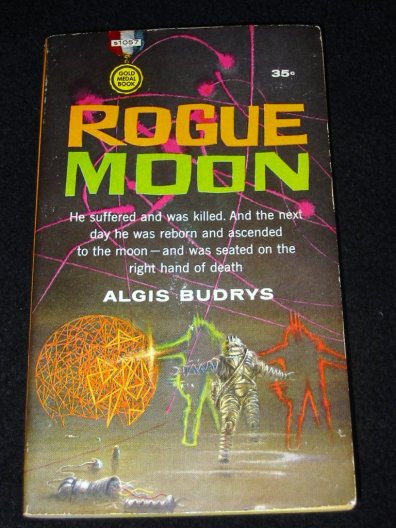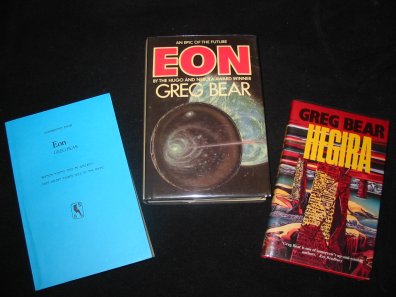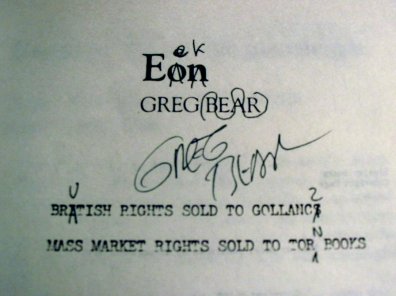

|
When the burning bush spoke in the voice of God, Moses must have trembled in fright and in awe and in sheer wonder at the unknowable mystery partially revealed. The BDO is the technological counterpart to the Ark of the Covenant and the Holy Grail. The stories are often couched in terms common to accounts of divine or mystical experiences, and religious themes abound. AUTHOR'S NOTE: unless otherwise specified, estimated values offered below refer to first printings of first trade editions in hardback with dust jackets present in Fine/Fine condition. PB and PBO refer to paperback and paperback original, respectively.
Arthur C. Clarke: 2001: A Space Odyssey Perhaps the quintessential BDO in SF is the monolith of Arthur C Clarke's 2001: A Space Odyssey. The movie fired the imagination of (and/or confused the hell out of) its audience, with striking images of pre-human primates encountering a black slab-like monolith before inventing the first tool (a club used to slaughter the alpha male of a rival band), another monolith found buried on the Moon, a computer too smart for our own good, an hallucinogenic trip through yet another monolith in orbit around Jupiter, leading to the final image of the Starchild contemplating Earth from orbit while meditatively sucking its thumb. (For a remarkably simple yet insightful explanation of the movie, take a look here.) The mystical/religious symbolism of the monolith is quite clear. It's no accident that its dimensions resemble those of a door nor that it appears at three critical points in the development of the human species: the transition from animal-like primate to tool-user, from earth-bound species to a space-faring one, and in the transcendent metamorphosis from human to Starchild. Note: the book is essentially a novelization of the movie, which in turn was based on Clarke's short story "The Sentinel." In this story, an explorer on the Moon finds an ancient alien artifact which, when tinkered with, sends a signal to deep space - in effect, a tripwire left behind to warn that the monkeys have managed to leave their planet.
Algis Budrys: Rogue Moon

Philip Jose Farmer: To Your Scattered Bodies Go In Algis Budrys' Rogue Moon, an enigmatic and highly lethal alien construct is found on the lunar surface, and a matter transmitter is used to send a string of copies of death-obsessed Al Barker to explore the deadly maze. The original Barker telepathically shares in the experience as each copy enters the labyrinth and progresses a little further than his predecessor, before suffering yet another gruesome death. Sacrifice, death, and rebirth - all for the greater good of humanity. Death and rebirth is also the central theme of Philip Jose Farmer's To Your Scattered Bodies Go, which features an artificial planet, apparently constructed by aliens, with a great River that corkscrews from one pole to the other. Along the banks of this River, every human who has ever lived is brought back to life. (Interestingly, in the context of this discussion, one book in the Riverworld series is titled The Magic Labyrinth.) What is the purpose of the maze on the moon? Who are the mysterious aliens who have resurrected the human race on an alien planet? Are these not an echo of the central questions that all humans ask: who am I, and why am I here? In Rogue Moon, Budrys writes of the alien maze: "Perhaps it's the alien equivalent of a discarded tomato can. Does a beetle know why it can enter the can only from one end as it lies across the trail to the beetle's burrow? Does the beetle understand why it is harder to climb to the left or right, inside the can, than it is to follow a straight line? Would the beetle be a fool to assume the human race put the can there to torment it - or an egomaniac to believe the can was manufactured only to mystify it?" In other words, perhaps it is an act of hubris to even question the mystery, to ask a question that presupposes that there is an answer that we can understand, or to assume that the powers that hold the answers care one way or the other.
John Varley: Titan John Varley's Titan (and subsequent novels) tells the story of a human ship on an exploration mission to Saturn, where a sentient, moon-sized organism named Gaea is discovered. Gaea is arguably the most interesting character in the story. The Titan series is rich in classical mythological allusion, and the wonder and awe of the divine encounter pervades it. The interior of Gaea supports an incredibly rich biosphere, including numerous intelligent species to which Gaea is in effect a god. But increasing evidence of system breakdowns indicates that Gaea is growing senile, if not outright insane.
Frederick Pohl: Gateway In Frederick Pohl's Gateway (and its sequels), the long-departed Heechee have left various artifacts and installations scattered around the solar system. By far the most important is Gateway itself, a Heechee spaceport complete with working starships. Unfortunately, the technology is a complete mystery, as are the navigation controls. Gateway prospectors can only strap in and select from a Heechee database of pre-programmed destinations, with no knowledge of what waits on the other end. As a result, most prospectors end up very rich or very dead. In Robinette Broadhead's case, he ends up rich but wishing he were dead.
Bob Shaw: Orbitsville
Larry Niven: Ringworld
Arthur C. Clarke: Rendezvous with Rama
Greg Bear: Eon
Greg Bear: Hegira

In many cases the BDO serves as the overarching backdrop, the vast stage on which the characters play out their dramas. Bob Shaw's Orbitsville and its sequels feature a Dyson Sphere, named after Princeton physicist Freeman Dyson, who proposed in 1959 that an advanced civilization could convert all the matter of a solar system into an artificial sphere the size of a planetary orbit. Add water, land and atmosphere on the inner face to make a habitable area, and such a construct with a radius equal to that of Earth's orbit would contain over 600 million times the surface area of the Earth. Interestingly, there have been at least three legitimate astronomical surveys performed looking for evidence of Dyson Spheres. In Larry Niven's Ringworld (and its sequels), the BDO is a band-like structure orbiting a star, rotating to provide gravity. It features a habitable surface on the sun-side - a kind of subset of a Dyson sphere. The original Ballantine paperback edition of Ringworld contains one of SF's most well known bloopers. In the opening pages main character Louis Wu teleports from city to city around the Earth, arriving at local midnight just in time to celebrate his birthday again and again - a neat concept, except Niven gets the mechanics wrong and ends up with the Earth rotating in the wrong direction. The mistake was corrected in all subsequent printings. And lastly, in Arthur C Clarke's Rendezvous With Rama and Greg Bear's Eon (and their sequels in both cases), the BDO is an immense spaceship. Clarke's Rama is an alien spacecraft on an elliptical orbit through the solar system, giving humans just enough time to get a tantalizing glimpse of the mysteries on board before it leaves. In Bear's Eon, the Stone is an asteroid starship, a human device, apparently deserted, and apparently from the future - though not necessarily our future. Its multi-chambered inside is bigger than its outside should allow; the deepest chamber is apparently infinite in dimension. Earth has been teetering on the edge of global war, and the international turmoil that follows the Stone's sudden appearance in orbit tips the balance. Another BDO story of note by Greg Bear is Hegira; on the surface a fairly standard heroic fantasy quest story, but for the presence of the Obelisks - thousand-kilometer-tall structures with all of the history and knowledge of the "First-Born" engraved upon them. By the way, I purchased my proof copy of Eon online a few years back, and the seller cut the price because, he said, someone had written and doodled on the title page. That someone turns out to have been Greg Bear himself, which the author confirmed later at a book signing.

As a final note, I will observe that for many of the titles discussed, the authors have chosen to write sequels in order to develop the ideas raised in the first book. Almost inevitably, as the subsequent novels reveal more and more of the mystery of the BDO, (i.e., as more of the questions are given nice tidy answers), my feeling is that the whole thing becomes somewhat less interesting. The BDO story in its purest form evokes the frisson of awe and fear you feel telling stories around the campfire, as you imagine what crouches in the dark outside the circle of light. When the author turns on the floodlights and answers all the questions, I am left with mixed emotions - satisfaction on the one hand from having my curiosity sated, but also a vague feeling of having cheated by looking up the answers in the teacher's edition. Other titles of interest:
Ben Bova: As On A Darkling Plain
Jack McDevitt: Engines of God
Jack McDevitt: Ancient Shores
< to previous article
Questions or comments?
| Forum
| Store
| Publications
| BookLinks
| BookSearch
| BookTopics
| Archives
| Advertise
| AboutUs
| ContactUs
| Search Site
| Site Map
| Google Site Map
Store - Specials
| BookHunt
| BookShelf
| Gold Edition & BookThink's Quarterly Market Report
| DomainsForSale
| BookThinker newsletter - free
Copyright 2003-2011 by BookThink LLC
|

|